brake light FIAT DOBLO COMBI 2012 Owner handbook (in English)
[x] Cancel search | Manufacturer: FIAT, Model Year: 2012, Model line: DOBLO COMBI, Model: FIAT DOBLO COMBI 2012Pages: 283, PDF Size: 6.31 MB
Page 113 of 283
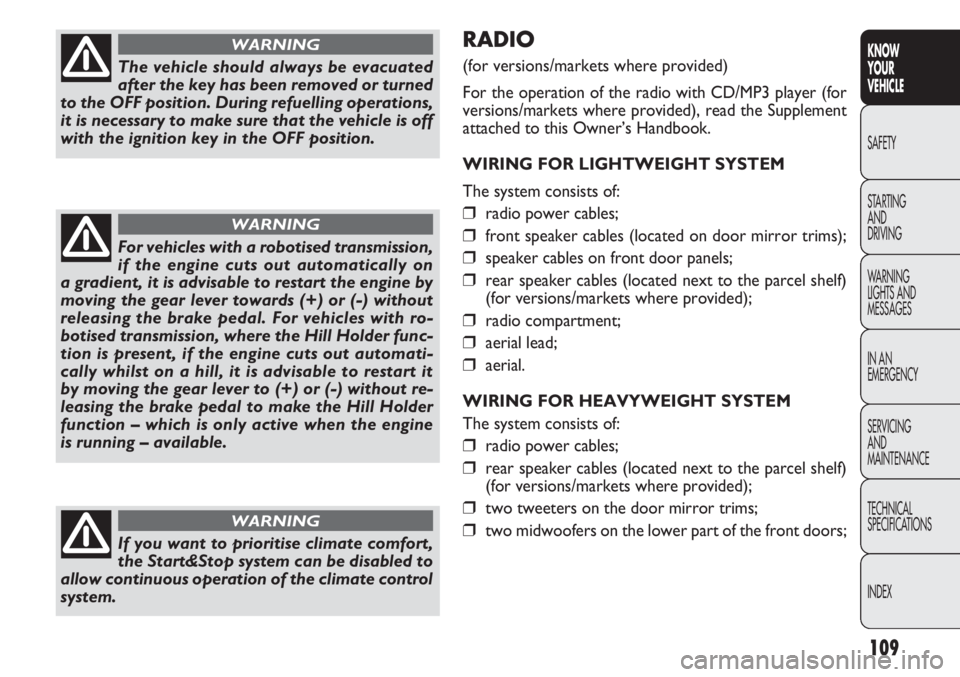
109
KNOW
YOUR
VEHICLE
SAFETY
STAR
TING
AND
DRIVING
WARNING
LIGHTS AND
MESSAGES
IN AN
EMERGENCY
SERVICING
AND
MAINTENANCE
TECHNICAL
SPECIFICATIONS
INDEX
RADIO
(for versions/markets where provided)
For the operation of the radio with CD/MP3 player (for
versions/markets where provided), read the Supplement
attached to this Owner’s Handbook.
WIRING FOR LIGHTWEIGHT SYSTEM
The system consists of:
❒radio power cables;
❒front speaker cables (located on door mirror trims);
❒speaker cables on front door panels;
❒rear speaker cables (located next to the parcel shelf)
(for versions/markets where provided);
❒radio compartment;
❒aerial lead;
❒aerial.
WIRING FOR HEAVYWEIGHT SYSTEM
The system consists of:
❒radio power cables;
❒rear speaker cables (located next to the parcel shelf)
(for versions/markets where provided);
❒two tweeters on the door mirror trims;
❒two midwoofers on the lower part of the front doors;
The vehicle should always be evacuated
after the key has been removed or turned
to the OFF position. During refuelling operations,
it is necessary to make sure that the vehicle is off
with the ignition key in the OFF position.
WARNING
For vehicles with a robotised transmission,
if the engine cuts out automatically on
a gradient, it is advisable to restart the engine by
moving the gear lever towards (+) or (-) without
releasing the brake pedal. For vehicles with ro-
botised transmission, where the Hill Holder func-
tion is present, if the engine cuts out automati-
cally whilst on a hill, it is advisable to restart it
by moving the gear lever to (+) or (-) without re-
leasing the brake pedal to make the Hill Holder
function – which is only active when the engine
is running – available.
WARNING
If you want to prioritise climate comfort,
the Start&Stop system can be disabled to
allow continuous operation of the climate control
system.
WARNING
Page 137 of 283
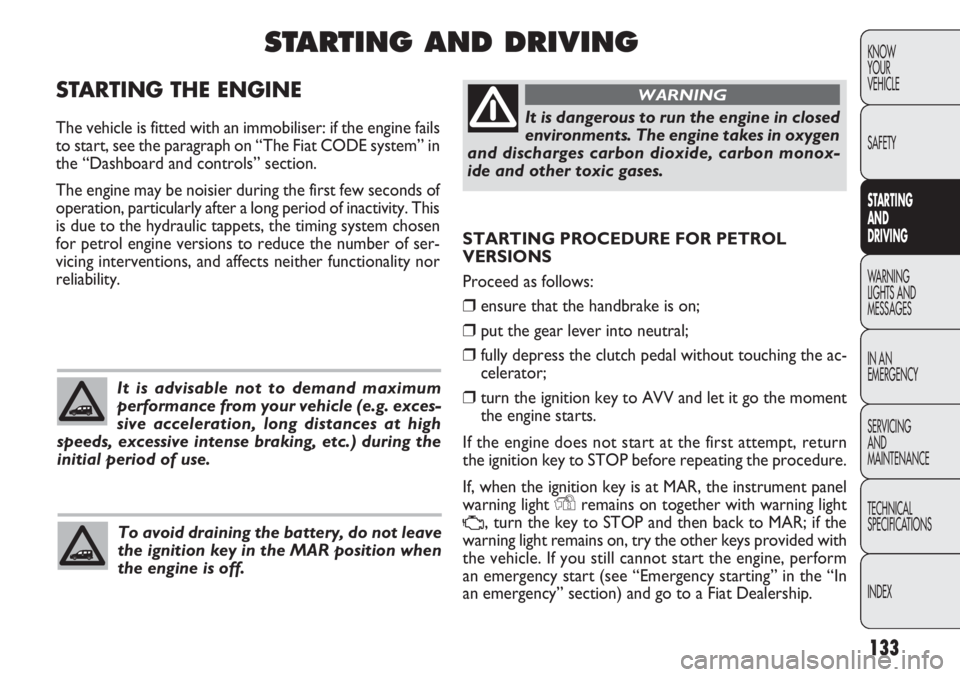
133
KNOW
YOUR
VEHICLE
SAFETY
STARTING
AN
D
DRIVING
WARNING
LIGHTS AND
MESSAGES
IN AN
EMERGENCY
SERVICING
AND
MAINTENANCE
TECHNICAL
SPECIFICA TIONS
INDEX
STARTING PROCEDURE FOR PETROL
VERSIONS
Proceed as follows:
❒ensure that the handbrake is on;
❒put the gear lever into neutral;
❒fully depress the clutch pedal without touching the ac-
celerator;
❒turn the ignition key to AVV and let it go the moment
the engine starts.
If the engine does not start at the first attempt, return
the ignition key to STOP before repeating the procedure.
If, when the ignition key is at MAR, the instrument panel
warning light
Yremains on together with warning light
U, turn the key to STOP and then back to MAR; if the
warning light remains on, try the other keys provided with
the vehicle. If you still cannot start the engine, perform
an emergency start (see “Emergency starting” in the “In
an emergency” section) and go to a Fiat Dealership.
STARTING THE ENGINE
The vehicle is fitted with an immobiliser: if the engine fails
to start, see the paragraph on “The Fiat CODE system” in
the “Dashboard and controls” section.
The engine may be noisier during the first few seconds of
operation, particularly after a long period of inactivity. This
is due to the hydraulic tappets, the timing system chosen
for petrol engine versions to reduce the number of ser-
vicing interventions, and affects neither functionality nor
reliability.
STARTING AND DRIVING
It is advisable not to demand maximum
performance from your vehicle (e.g. exces-
sive acceleration, long distances at high
speeds, excessive intense braking, etc.) during the
initial period of use.
To avoid draining the battery, do not leave
the ignition key in the MAR position when
the engine is off.
It is dangerous to run the engine in closed
environments. The engine takes in oxygen
and discharges carbon dioxide, carbon monox-
ide and other toxic gases.
WARNING
Page 138 of 283
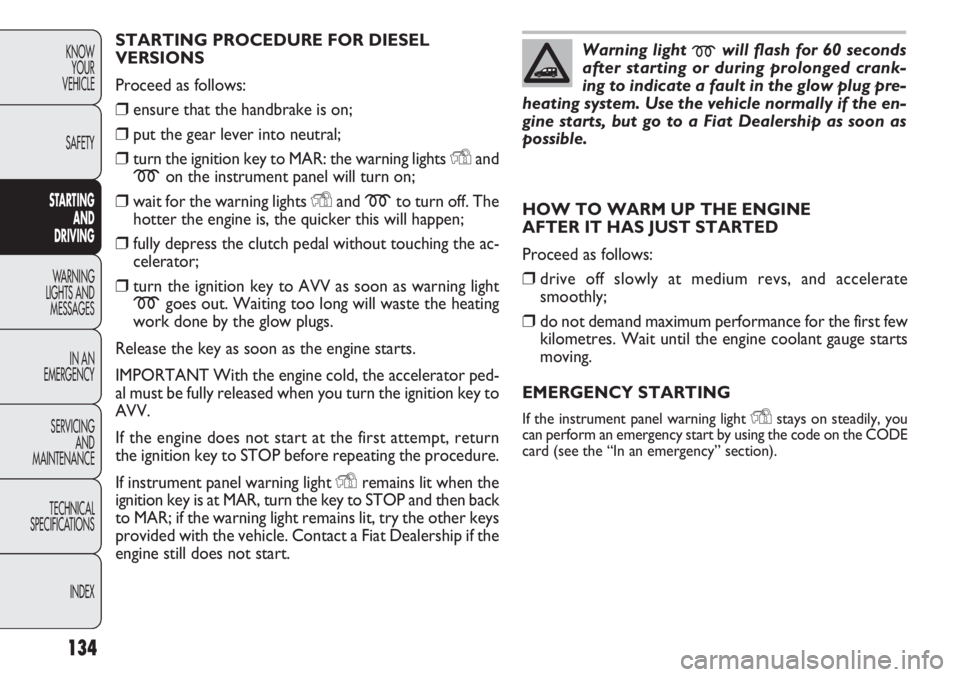
134
KNOWYOUR
VEHICLE
SAFETY
ST ARTING
AN
D
DRIVING
WARNING
LIGHTS AND MESSAGES
IN AN
EMERGENCY
SERVICING AND
MAINTENANCE
TECHNICAL
SPECIFICA TIONS
INDEX
STARTING PROCEDURE FOR DIESEL
VERSIONS
Proceed as follows:
❒ensure that the handbrake is on;
❒put the gear lever into neutral;
❒turn the ignition key to MAR: the warning lights Yand
mon the instrument panel will turn on;
❒wait for the warning lights Yand mto turn off. The
hotter the engine is, the quicker this will happen;
❒fully depress the clutch pedal without touching the ac-
celerator;
❒turn the ignition key to AVV as soon as warning light
mgoes out. Waiting too long will waste the heating
work done by the glow plugs.
Release the key as soon as the engine starts.
IMPORTANT With the engine cold, the accelerator ped-
al must be fully released when you turn the ignition key to
AVV.
If the engine does not start at the first attempt, return
the ignition key to STOP before repeating the procedure.
If instrument panel warning light
Yremains lit when the
ignition key is at MAR, turn the key to STOP and then back
to MAR; if the warning light remains lit, try the other keys
provided with the vehicle. Contact a Fiat Dealership if the
engine still does not start.
Warning light mwill flash for 60 seconds
after starting or during prolonged crank-
ing to indicate a fault in the glow plug pre-
heating system. Use the vehicle normally if the en-
gine starts, but go to a Fiat Dealership as soon as
possible.
HOW TO WARM UP THE ENGINE
AFTER IT HAS JUST STARTED
Proceed as follows:
❒drive off slowly at medium revs, and accelerate
smoothly;
❒do not demand maximum performance for the first few
kilometres. Wait until the engine coolant gauge starts
moving.
EMERGENCY STARTING
If the instrument panel warning light Ystays on steadily, you
can perform an emergency start by using the code on the CODE
card (see the “In an emergency” section).
Page 139 of 283
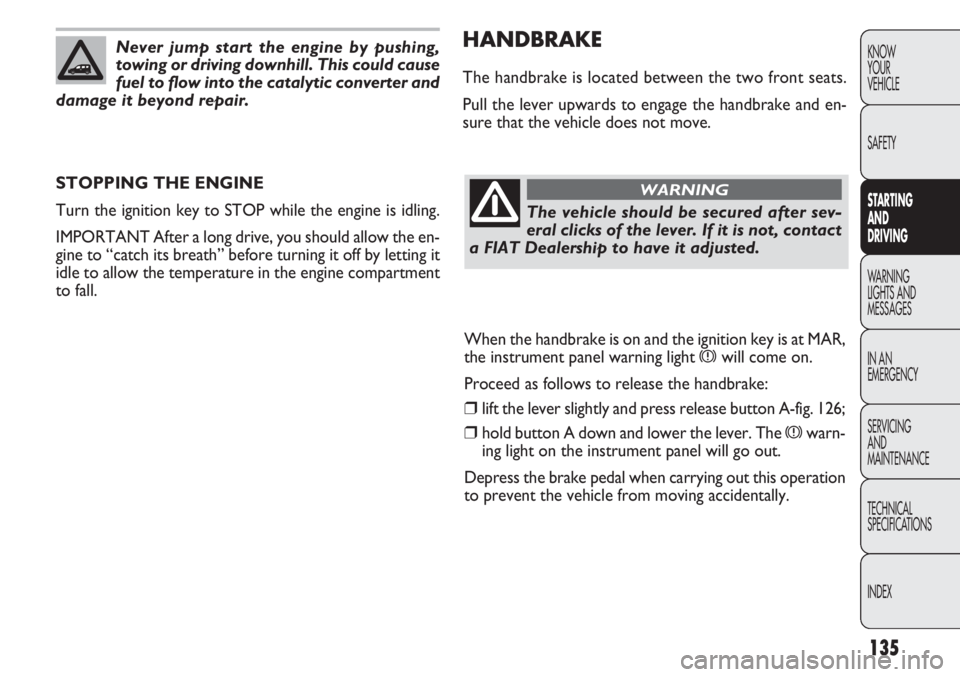
135
KNOW
YOUR
VEHICLE
SAFETY
STARTING
AN
D
DRIVING
WARNING
LIGHTS AND
MESSAGES
IN AN
EMERGENCY
SERVICING
AND
MAINTENANCE
TECHNICAL
SPECIFICA TIONS
INDEX
HANDBRAKE
The handbrake is located between the two front seats.
Pull the lever upwards to engage the handbrake and en-
sure that the vehicle does not move.
STOPPING THE ENGINE
Turn the ignition key to STOP while the engine is idling.
IMPORTANT After a long drive, you should allow the en-
gine to “catch its breath” before turning it off by letting it
idle to allow the temperature in the engine compartment
to fall.
Never jump start the engine by pushing,
towing or driving downhill. This could cause
fuel to flow into the catalytic converter and
damage it beyond repair.
The vehicle should be secured after sev-
eral clicks of the lever. If it is not, contact
a FIAT Dealership to have it adjusted.
WARNING
When the handbrake is on and the ignition key is at MAR,
the instrument panel warning light
xwill come on.
Proceed as follows to release the handbrake:
❒lift the lever slightly and press release button A-fig. 126;
❒hold button A down and lower the lever. The xwarn-
ing light on the instrument panel will go out.
Depress the brake pedal when carrying out this operation
to prevent the vehicle from moving accidentally.
Page 140 of 283
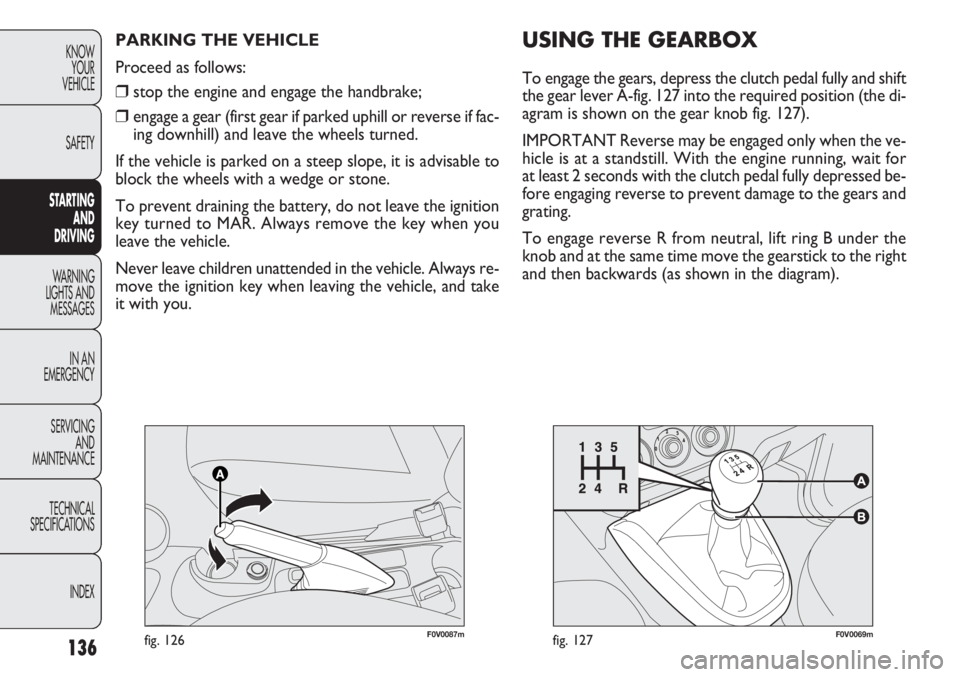
136
KNOWYOUR
VEHICLE
SAFETY
ST ARTING
AN
D
DRIVING
WARNING
LIGHTS AND MESSAGES
IN AN
EMERGENCY
SERVICING AND
MAINTENANCE
TECHNICAL
SPECIFICA TIONS
INDEX
F0V0069mfig. 127F0V0087mfig. 126
PARKING THE VEHICLE
Proceed as follows:
❒stop the engine and engage the handbrake;
❒engage a gear (first gear if parked uphill or reverse if fac-
ing downhill) and leave the wheels turned.
If the vehicle is parked on a steep slope, it is advisable to
block the wheels with a wedge or stone.
To prevent draining the battery, do not leave the ignition
key turned to MAR. Always remove the key when you
leave the vehicle.
Never leave children unattended in the vehicle. Always re-
move the ignition key when leaving the vehicle, and take
it with you.
USING THE GEARBOX
To engage the gears, depress the clutch pedal fully and shift
the gear lever A-fig. 127 into the required position (the di-
agram is shown on the gear knob fig. 127).
IMPORTANT Reverse may be engaged only when the ve-
hicle is at a standstill. With the engine running, wait for
at least 2 seconds with the clutch pedal fully depressed be-
fore engaging reverse to prevent damage to the gears and
grating.
To engage reverse R from neutral, lift ring B under the
knob and at the same time move the gearstick to the right
and then backwards (as shown in the diagram).
Page 143 of 283
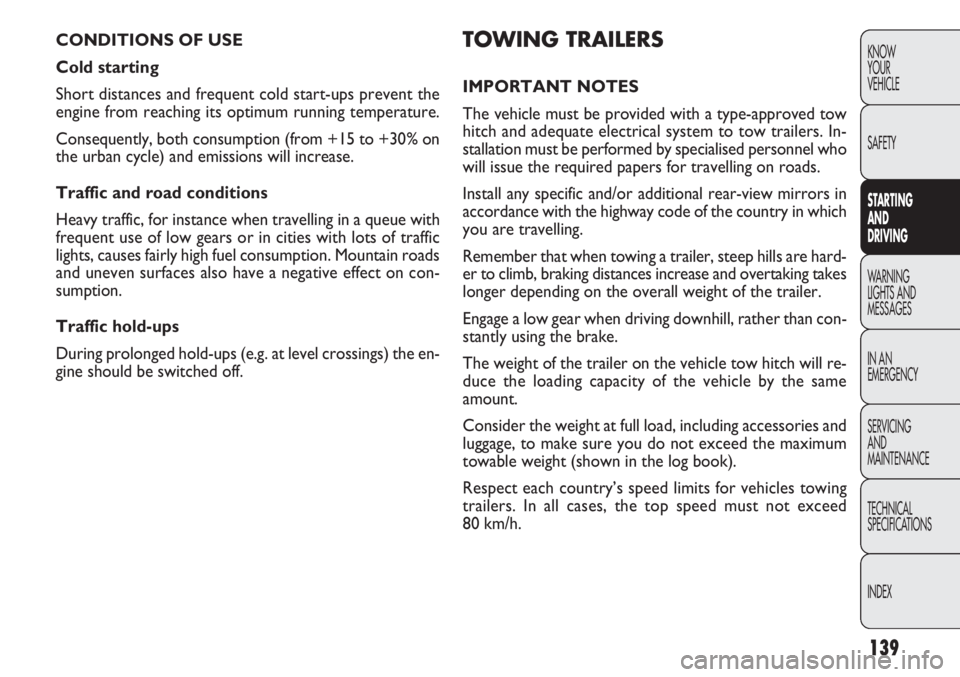
139
KNOW
YOUR
VEHICLE
SAFETY
STARTING
AN
D
DRIVING
WARNING
LIGHTS AND
MESSAGES
IN AN
EMERGENCY
SERVICING
AND
MAINTENANCE
TECHNICAL
SPECIFICA TIONS
INDEX
TOWING TRAILERS
IMPORTANT NOTES
The vehicle must be provided with a type-approved tow
hitch and adequate electrical system to tow trailers. In-
stallation must be performed by specialised personnel who
will issue the required papers for travelling on roads.
Install any specific and/or additional rear-view mirrors in
accordance with the highway code of the country in which
you are travelling.
Remember that when towing a trailer, steep hills are hard-
er to climb, braking distances increase and overtaking takes
longer depending on the overall weight of the trailer.
Engage a low gear when driving downhill, rather than con-
stantly using the brake.
The weight of the trailer on the vehicle tow hitch will re-
duce the loading capacity of the vehicle by the same
amount.
Consider the weight at full load, including accessories and
luggage, to make sure you do not exceed the maximum
towable weight (shown in the log book).
Respect each country’s speed limits for vehicles towing
trailers. In all cases, the top speed must not exceed
80 km/h.
CONDITIONS OF USE
Cold starting
Short distances and frequent cold start-ups prevent the
engine from reaching its optimum running temperature.
Consequently, both consumption (from +15 to +30% on
the urban cycle) and emissions will increase.
Traffic and road conditions
Heavy traffic, for instance when travelling in a queue with
frequent use of low gears or in cities with lots of traffic
lights, causes fairly high fuel consumption. Mountain roads
and uneven surfaces also have a negative effect on con-
sumption.
Traffic hold-ups
During prolonged hold-ups (e.g. at level crossings) the en-
gine should be switched off.
Page 144 of 283
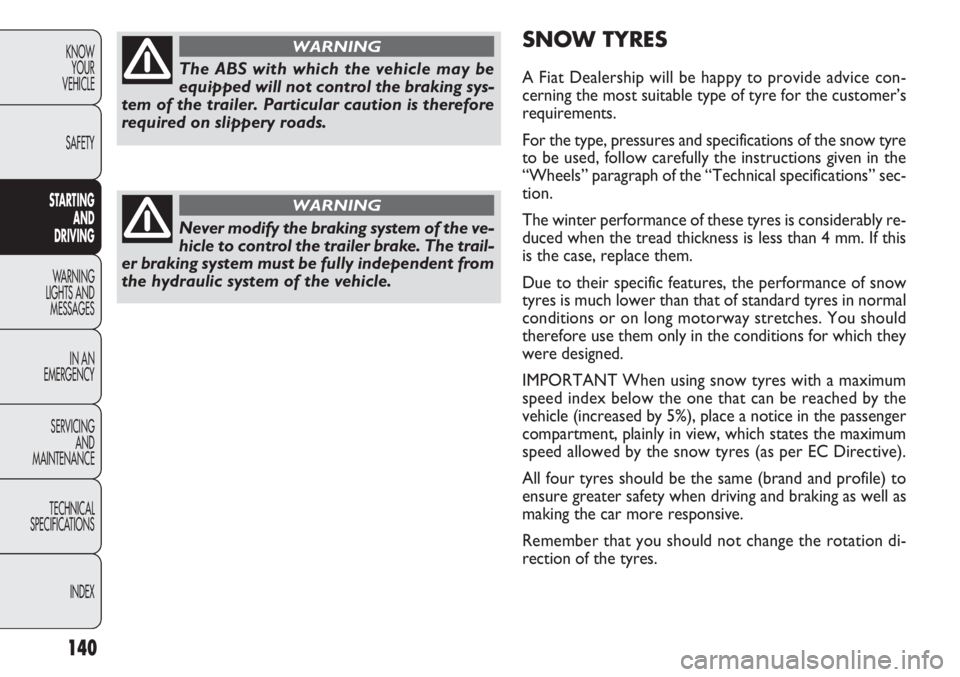
140
KNOWYOUR
VEHICLE
SAFETY
ST ARTING
AN
D
DRIVING
WARNING
LIGHTS AND MESSAGES
IN AN
EMERGENCY
SERVICING AND
MAINTENANCE
TECHNICAL
SPECIFICA TIONS
INDEX
SNOW TYRES
A Fiat Dealership will be happy to provide advice con-
cerning the most suitable type of tyre for the customer’s
requirements.
For the type, pressures and specifications of the snow tyre
to be used, follow carefully the instructions given in the
“Wheels” paragraph of the “Technical specifications” sec-
tion.
The winter performance of these tyres is considerably re-
duced when the tread thickness is less than 4 mm. If this
is the case, replace them.
Due to their specific features, the performance of snow
tyres is much lower than that of standard tyres in normal
conditions or on long motorway stretches. You should
therefore use them only in the conditions for which they
were designed.
IMPORTANT When using snow tyres with a maximum
speed index below the one that can be reached by the
vehicle (increased by 5%), place a notice in the passenger
compartment, plainly in view, which states the maximum
speed allowed by the snow tyres (as per EC Directive).
All four tyres should be the same (brand and profile) to
ensure greater safety when driving and braking as well as
making the car more responsive.
Remember that you should not change the rotation di-
rection of the tyres.The ABS with which the vehicle may be
equipped will not control the braking sys-
tem of the trailer. Particular caution is therefore
required on slippery roads.
WARNING
Never modify the braking system of the ve-
hicle to control the trailer brake. The trail-
er braking system must be fully independent from
the hydraulic system of the vehicle.
WARNING
Page 146 of 283
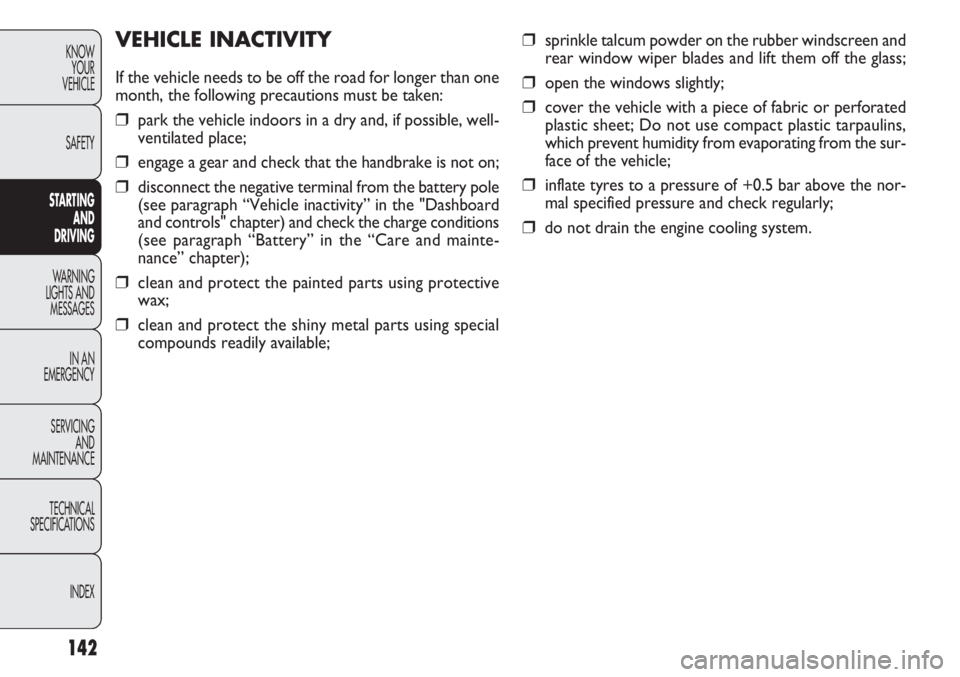
142
KNOWYOUR
VEHICLE
SAFETY
ST ARTING
AN
D
DRIVING
WARNING
LIGHTS AND MESSAGES
IN AN
EMERGENCY
SERVICING AND
MAINTENANCE
TECHNICAL
SPECIFICA TIONS
INDEX
❒sprinkle talcum powder on the rubber windscreen and
rear window wiper blades and lift them off the glass;
❒open the windows slightly;
❒cover the vehicle with a piece of fabric or perforated
plastic sheet; Do not use compact plastic tarpaulins,
which prevent humidity from evaporating from the sur-
face of the vehicle;
❒inflate tyres to a pressure of +0.5 bar above the nor-
mal specified pressure and check regularly;
❒do not drain the engine cooling system.
VEHICLE INACTIVITY
If the vehicle needs to be off the road for longer than one
month, the following precautions must be taken:
❒park the vehicle indoors in a dry and, if possible, well-
ventilated place;
❒engage a gear and check that the handbrake is not on;
❒disconnect the negative terminal from the battery pole
(see paragraph “Vehicle inactivity” in the "Dashboard
and controls" chapter) and check the charge conditions
(see paragraph “Battery” in the “Care and mainte-
nance” chapter);
❒clean and protect the painted parts using protective
wax;
❒clean and protect the shiny metal parts using special
compounds readily available;
Page 147 of 283

143
KNOW
YOUR
VEHICLE
SAFETY
STARTING
AND
DRIVING
WA R N I NG
LIGHTS AND
MESSAGES
IN AN
EMERGENCY
SERVICING
AND
MAINTENANCE
TECHNICAL
SPECIFICA TIONS
INDEX
WARNING LIGHTS AND MESSAGES
GENERAL WARNINGS
Warning lights are accompanied by a specific message
and/or sound when applicable. These indications are brief
and precautionary and as such must not be considered as
exhaustive and/or alternative to the information contained
in the Owner’s Handbook, which you are recommended
to read carefully in all cases. Always refer to the informa-
tion in this chapter in the event of a failure indication.
IMPORTANT The fault indicators appearing on the dis-
play are divided into two categories: very serious and less
serious failures.
Very serious failures prompt a prolonged cycle of signals.
Less serious failures prompt a shorter cycle of signals.
Press SET ESC to stop the warning cycle in both cases.
Warning lights (or the symbol on the display) on the in-
strument panel will stay on until the cause of the failure
is eliminated.
WARNING LIGHTS AND MESSAGES
If the warning light xturns on when trav-
elling (on certain versions together with
the message on the display), stop the car imme-
diately and contact a Fiat Dealership.
WARNING
BRAKE FLUID LOW (red)
HANDBRAKE ON (red)
When the ignition key is turned to MAR,
the warning light turns on but should go off after a few
seconds.
Brake fluid low
The warning light turns on when the level of the brake flu-
id in the reservoir falls below the minimum level, possi-
bly due to a leak in the circuit.
On some versions the display shows the associated
message.
x
Handbrake on
The warning light turns on when the handbrake is engaged.
On certain versions, there is also an audible warning if
the vehicle is moving.
IMPORTANT If the warning light turns on when travel-
ling, check that the handbrake is not engaged.
Page 156 of 283
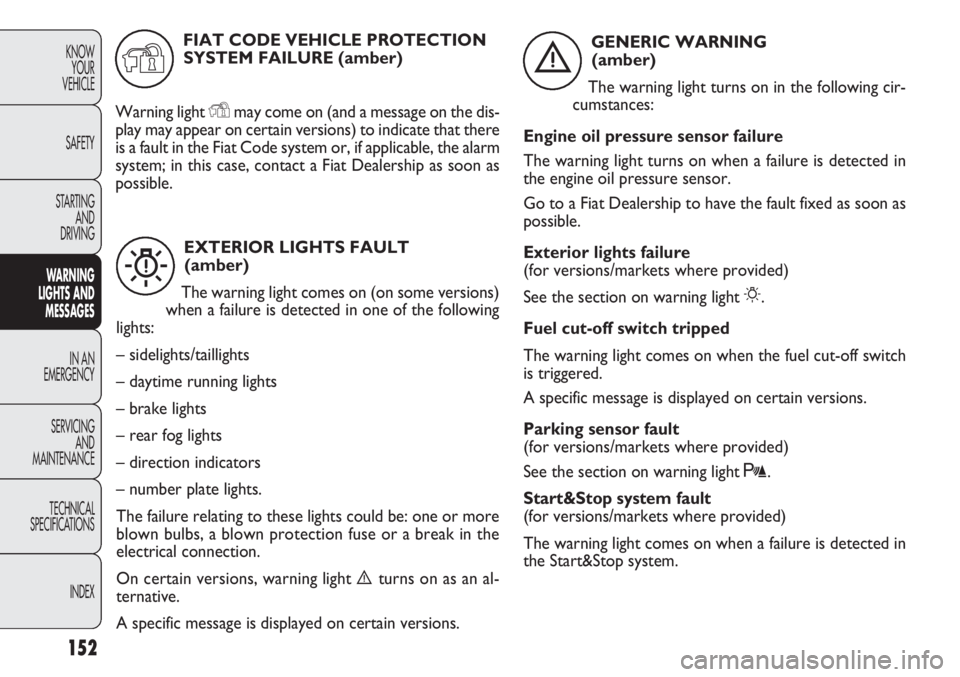
152
KNOWYOUR
VEHICLE
SAFETY
STARTING AND
DRIVING
WARNING
LIGHTS AND MESSAGES
IN AN
EMERGENCY
SERVICING AND
MAINTENANCE
TECHNICAL
SPECIFICA TIONS
INDEX
EXTERIOR LIGHTS FAULT(amber)
The warning light comes on (on some versions)
when a failure is detected in one of the following
lights:
– sidelights/taillights
– daytime running lights
– brake lights
– rear fog lights
– direction indicators
– number plate lights.
The failure relating to these lights could be: one or more
blown bulbs, a blown protection fuse or a break in the
electrical connection.
On certain versions, warning light è turns on as an al-
ternative.
A specific message is displayed on certain versions.
W
GENERIC WARNING (amber)
The warning light turns on in the following cir-
cumstances:
Engine oil pressure sensor failure
The warning light turns on when a failure is detected in
the engine oil pressure sensor.
Go to a Fiat Dealership to have the fault fixed as soon as
possible.
Exterior lights failure
(for versions/markets where provided)
See the section on warning light
6.
Fuel cut-off switch tripped
The warning light comes on when the fuel cut-off switch
is triggered.
A specific message is displayed on certain versions.
Parking sensor fault
(for versions/markets where provided)
See the section on warning light t.
Start&Stop system fault
(for versions/markets where provided)
The warning light comes on when a failure is detected in
the Start&Stop system.
è
FIAT CODE VEHICLE PROTECTION SYSTEM FAILURE (amber)
Warning light
Ymay come on (and a message on the dis-
play may appear on certain versions) to indicate that there
is a fault in the Fiat Code system or, if applicable, the alarm
system; in this case, contact a Fiat Dealership as soon as
possible.
Y